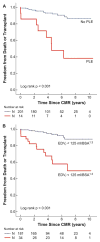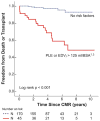Cardiac magnetic resonance parameters predict transplantation-free survival in patients with fontan circulation
- PMID: 24619103
- PMCID: PMC4262249
- DOI: 10.1161/CIRCIMAGING.113.001473
Cardiac magnetic resonance parameters predict transplantation-free survival in patients with fontan circulation
Erratum in
-
Correction to: Cardiac Magnetic Resonance Parameters Predict Transplantation-Free Survival in Patients With Fontan Circulation.Circ Cardiovasc Imaging. 2018 Nov;11(11):e000021. doi: 10.1161/HCI.0000000000000021. Circ Cardiovasc Imaging. 2018. PMID: 30571324 No abstract available.
Abstract
Background: Several clinical risk factors for death and heart transplantation have been identified in patients with Fontan circulation. It is unknown whether cardiac magnetic resonance (CMR) measurements of ventricular size and function are independently associated with these outcomes and further improve risk stratification.
Methods and results: Data on patients with Fontan circulation who had a CMR study from January 2002 to January 2011 were retrospectively reviewed. The end point was time to death or listing for heart transplantation after the CMR study. The median age of the 215 patients was 18.3 years (25th, 75th percentiles: 14, 26) with a median age at Fontan of 3.6 years (2.3, 7.1). During a median post-CMR follow-up period of 4.1 years (2.6, 6.2), 24 patients (11%) reached the end point: 20 deaths, 3 transplantations, and 1 transplantation listing. In a multivariable Cox regression model with clinical parameters only, protein-losing enteropathy was associated with death or listing for transplant. A multivariable model, including clinical and CMR parameters, showed that in addition to protein-losing enteropathy, ventricular indexed end-diastolic volume >125 mL/body surface area raised to the 1.3 power was associated with the endpoint. A likelihood-ratio test comparing the 2 models showed that the addition of indexed end-diastolic volume resulted in a significantly improved end point prediction (P<0.001)-C-index increased from 0.63 to 0.79.
Conclusions: CMR-derived ventricular indexed end-diastolic volume is an independent predictor of death or transplant in patients late after the Fontan operation and adds incremental value over clinical symptoms alone for risk stratification.
Keywords: Fontan procedure; heart defects, congenital; magnetic resonance imaging.
© 2014 American Heart Association, Inc.
Figures


References
-
- Anderson PA, Sleeper LA, Mahony L, Colan SD, Atz AM, Breitbart RE, Gersony WM, Gallagher D, Geva T, Margossian R, McCrindle BW, Paridon S, Schwartz M, Stylianou M, Williams RV, Clark BJ., 3rd Contemporary outcomes after the Fontan procedure: A pediatric heart network multicenter study. J Am Coll Cardiol. 2008;52:85–98. - PMC - PubMed
-
- Khairy P, Fernandes SM, Mayer JE, Jr, Triedman JK, Walsh EP, Lock JE, Landzberg MJ. Long-term survival, modes of death, and predictors of mortality in patients with Fontan surgery. Circulation. 2008;117:85–92. - PubMed
-
- Piran S, Veldtman G, Siu S, Webb GD, Liu PP. Heart failure and ventricular dysfunction in patients with single or systemic right ventricles. Circulation. 2002;105:1189–1194. - PubMed
-
- Mertens L, Hagler DJ, Sauer U, Somerville J, Gewillig M. Protein-losing enteropathy after the Fontan operation: An international multicenter study. Ple study group. J Thorac Cardiovasc Surg. 1998;115:1063–1073. - PubMed
-
- Fernandes SM, Alexander ME, Graham DA, Khairy P, Clair M, Rodriguez E, Pearson DD, Landzberg MJ, Rhodes J. Exercise testing identifies patients at increased risk for morbidity and mortality following Fontan surgery. Congenit Heart Dis. 2011;6:294–303. - PubMed
Publication types
MeSH terms
Substances
Grants and funding
LinkOut - more resources
Full Text Sources
Other Literature Sources
Medical

